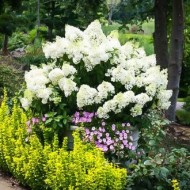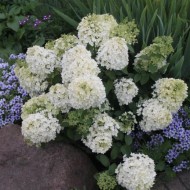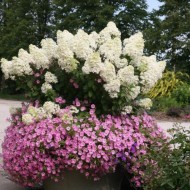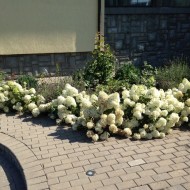Bobo dwarf hydrangea in garden design: planting and care rules
Content
Bobo hydrangea history
The ornamental shrub Hydrangea paniculata Bobo was developed by Belgian originators about ten years ago. In 2011, the cultivar of the luxury series was awarded the prestigious award and the title of "Best Variety" at the international floral exhibition Florall (Ghent, Belgium). After such an overwhelming success, the hybrid quickly gained popularity with gardeners throughout Europe. Due to its increased winter hardiness, the plant is grown even in the north of Russia.

Description and photo of hydrangea paniculata Bobo
The dwarf Hydrangea paniculata Bobo belongs to the deciduous crops of the Hortensia family. The height of an adult plant is 0.6-0.7 m. The culture forms a compact ball-shaped bush about half a meter wide. According to the botanical description, a slow-growing hybrid is characterized by an annual growth of 8-10 cm.
The shoots of Bobo's hydrangea are erect, covered with burgundy-brown bark, densely leafy. Due to its strength, the stems do not break during flowering and retain the correct shape of the bush. The leaf plates are ovoid, emerald green, with finely jagged edges and clearly visible veins.
During continuous flowering, which lasts from July to October, the cultivar throws out large cone-shaped inflorescences. They consist of many small flowers of a chameleon color - at the beginning of flowering, the color is pistachio, then it becomes white, towards autumn it acquires a delicate pinkish tint, and by the end of September it brightens to cream-pastel.

Pros and cons of the variety
Hydrangea paniculata Bobo is not in vain awarded the title of "Best Grade".
- increased winter hardiness (up to -25 ° С);
- good disease resistance;
- long and abundant flowering;
- the possibility of growing in the form of a room culture;
- high decorative qualities.
- the need to constantly monitor the acidity of the soil;
- strict adherence to the irrigation scheme;
- vulnerability of the root system due to its proximity to the surface.
Video "Description of Bobo hydrangea"
This video shows what an ornamental garden culture looks like.
Growing from seeds
This method is used when there is a need to get a large batch of young animals to decorate a garden plot. It is not difficult to grow a hydrangea in this way, you just need to adhere to the basic agrotechnical rules.
Seat selection
Hydrangea paniculata Bobo is comfortable in areas with moderate shade. The hybrid does not like direct sunlight, as they can lead to burns of the aerial part of the plant. You should also avoid northerly winds and drafts. Since the cultivar does not tolerate drying out of the soil, it is not recommended to plant it on hills.The place should retain moisture well, but not be prone to stagnant water.
Soil preparation
Bobo variety grows only on nutritious, well-drained soils. Acidity is allowed neutral and increased.
The more acidic the soil, the brighter the color of the inflorescences will be.
An alkaline environment is categorically unsuitable for cultivating. If the pH drops too much, there is a risk that the plant will die. The optimal substrate for planting paniculate hydrangea will be a mixture of peat, humus, sand and garden soil, taken in equal proportions.
Selection and preparation of seeds
To get an original hybrid with all varietal characteristics, it is necessary to use only high-quality seed. It must be fresh, harvested no later than a year ago. Preparation for disembarkation begins in February-March and consists of several stages:
- seeds are sown in containers filled with peat and sand;
- the surface is moistened with a spray bottle, and then covered with plastic wrap;
- before the first shoots appear, the planting material is kept at a temperature not lower than +20 ° C, periodically airing;
- after the appearance of the second full-fledged leaf, a pick is carried out, transplanting the seedlings into new containers;
- in the second decade of May, the grown seedlings are planted in separate flowerpots.
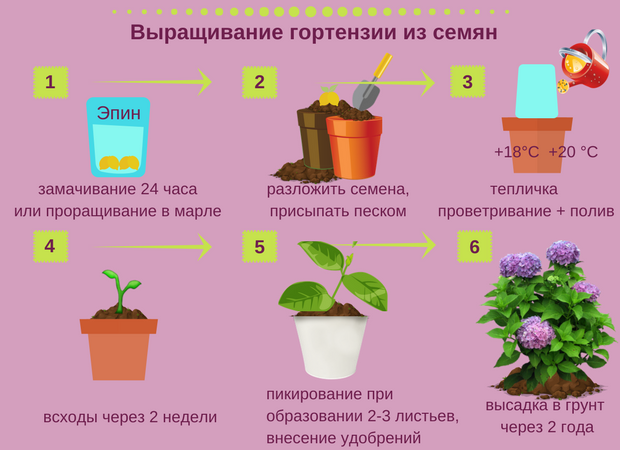
Landing algorithm
Before planting on the site, the hydrangea is grown in pots for 2-3 years. When the young are ready for transplanting, they are moved to a permanent place, following a specific algorithm:
- dig out landing holes 60x40 cm in size with an interval of at least half a meter from each other;
- a drainage layer of expanded clay or broken brick is laid on the bottom;
- partially fill the hole with a pre-prepared substrate;
- place the seedling, gently straightening the roots and placing the root collar flush with the surface;
- fall asleep with the remnants of the soil mixture, and then form a near-trunk circle;
- a bucket of water is poured under the bush;
- mulch with sawdust or peat.
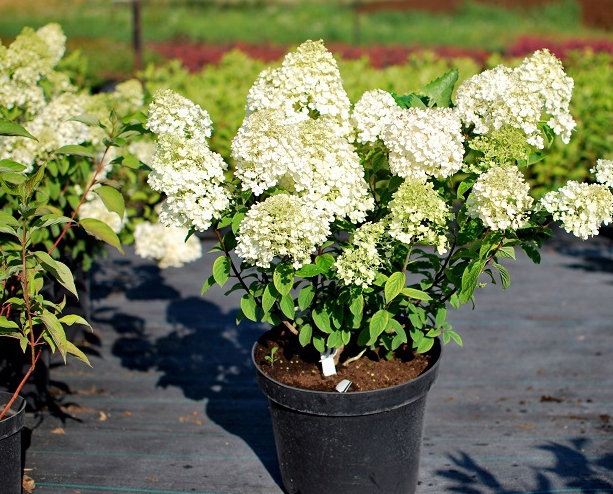
Bobo hydrangea care rules
Compliance with the watering scheme is mandatory for the normal growth of the cultivar. In spring and autumn, moistening is carried out weekly, pouring 10 liters of settled water under each bush. During extreme heat or drought, the frequency is doubled. After each procedure, the soil is gently loosened, and sprouted weeds are also removed.
The hybrid is fed throughout the season:
- use organic matter in early spring;
- during budding and flowering, potassium-phosphorus compounds are introduced;
- before wintering, fertilize with superphosphate.
Formative pruning is carried out every spring for hydrangeas. Before the start of the movement of juices, they remove frozen, dry or broken branches, as well as cut off the wrong growing ones. The remaining annual shoots are shortened to the fifth bud. In the fall, dried inflorescences are cut off, capturing the first two eyes with them.
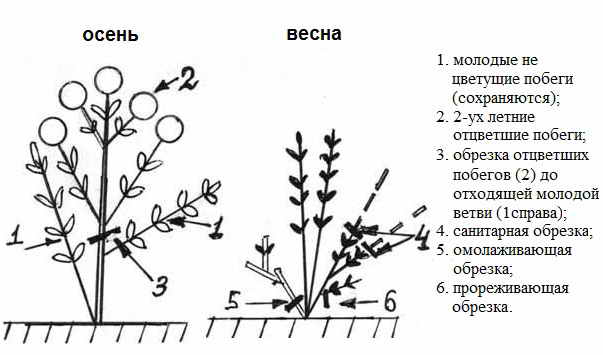
Preparation for the cold season begins by stopping watering and applying the last dressing. The soil around is lined with a mulch layer 10 cm thick from sawdust or peat, and dry foliage is thrown over the bushes on top. Next, spruce branches are laid out, and then covered with polyethylene.
Common diseases and pests
With a high immunity to infections, Bobo rarely gets sick. Problems usually arise from improper care. So, with a lack of iron in the soil, the cultivar can get sick with chlorosis. The introduction of iron-containing preparations under the root will help to defeat the disease.
Also, the hybrid is sometimes affected by downy mildew. The appearance of yellow spots on the green part of the plant indicates an overly humid environment.At the first signs of the disease, the bush is sprayed with a fungicide solution, for example, "Fundazol".
Often, aphids or spider mites settle on hydrangeas. You can get rid of them with the help of insecticides (for example, "Aktara" or "Aktellik"). But it is better to collect snails or slugs mechanically (by hand).
The use of Bobo hydrangea in landscaping
The deluxe miniature cultivar can be used in different ways:
- plant hedges;
- arrange paths or entrances;
- perform curb landings;
- add mixborders;
- create mobile flowerpots;
- add to floral arrangements.
Best of all, the Bobo hybrid is combined with phlox of a white and pink palette or other hydrangeas. Flowering ornamental shrubs will also be good neighbors for the hybrid.
- Mixed type mixborder
- Flower bed
- Composite fit
- Curb landing
Gardeners reviews
“I learned about Bobo from reviews on the Internet when I was choosing what to decorate the driveway with. I bought seedlings in the nursery and planted them strictly according to the rules. Hydrangea has taken up well, pleases with abundant flowering, and also tolerates winter well. "
“As a landscape designer, I often advise clients to choose Bobo for landscaping. From my own experience, I was convinced that she needs minimal care and at the same time does not lose her decorative qualities. "
Despite its diminutiveness, Bobo hydrangea can become a decoration of any garden. Subject to the rules of agricultural technology, this ornamental shrub will delight with lush flowering until mid-autumn.

